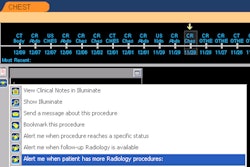The use of cloud computing technology for radiology image exchange can improve quality of care while decreasing costs and improving relationships with referring institutions and providers, according to a presentation at the annual Healthcare Information and Management Systems Society (HIMSS) meeting.
Launched in six months as part of Houston-based Memorial Hermann Healthcare System's information exchange program, the cloud-based image sharing program also dovetails with the health system's evolution towards an accountable care organization (ACO) model, according to chief information, marketing, and planning officer David Bradshaw.
Bradshaw and information systems division administrative director Robert Weeks described the Memorial Hermann experience with cloud-based image exchange during a Friday session at HIMSS 2012.
Investing in ACO model
Memorial Hermann is a large healthcare system in Houston with 15 total hospitals, including nine acute hospitals, one children's hospital, three heart and vascular institutes, and two rehabilitation hospitals. It also includes 29 imaging centers, 25 sports medicine and rehab centers, 25 diagnostic laboratories, 17 ambulatory surgical centers, one retirement/nursing center, and one home health agency, according to Bradshaw.
The system has a large regional footprint, with 145 Memorial Hermann facilities in the Houston area.
Memorial Hermann performs 2.2 million imaging studies per year. As it looks to the future, Memorial Hermann has been quietly investing in building an ACO structure, Bradshaw said.
"We believe that our business model will change from being in the 'sick' business, where people pay us fee-for-service, to the wellness business, where we're ultimately going to get a fixed payment or ... capitation," he said. "We just see that as a revolving marketplace, and we're trying to evolve and transform our system to accomplish that and to be good at that."
While fee-for-service still makes up more than 90% of the system's income, Memorial Hermann recently signed its first capitated contract.
"Our job then was to build an IT infrastructure to support this transition as our business model changes," he said.
As part of this goal and to facilitate community-wide interoperability, Memorial Hermann two years ago formed the Memorial Hermann Information Exchange (MHiE), a nonprofit subsidiary.
"We have lots of different islands of data, islands of information," he said. "MHiE's purpose is to connect those islands together, both images as well as data. Doctors to hospitals, hospitals to freestanding emergency rooms for intakes, postacute providers, and then even we see consumers interacting with this integrated system through the MHiE company."
Image Gateway
The cloud-based image exchange service, called Image Gateway, is one of MHiE's "products," Bradshaw said.
Members of the MHiE can use Image Gateway (provided by DICOM Grid) to share images. The gateway is utilized to replace CDs and films from transfer patients, for trauma network image transfers, for routine transfers with images, and for provider-to-provider sharing of images, Weeks said. The institution also uses Image Gateway to provide a backup for its PACS network.
In trauma exchange cases, images are captured at the transferring facility and then routed from the modality to the Image Gateway. A Gateway Appliance at the transferring facility receives the image and then performs a proprietary process to remove the DICOM metadata from the image series, compresses the image series, and then transfers it over a secure connection to the transfer center.
"Our appliance that sits in our data center then captures those images -- the encrypted metadata and the compressed images -- uncompresses and merges those things back together, at which time they are automatically dropped to our PACS," he said. "Our PACS is ubiquitously available at all of our hospitals and through Web-based access. That's all before patients show up."
Improved patient care
The Image Gateway has provided improvements in patient care, the institution has found. For example, a 10-year-old girl in Beaumont, TX, had suffered a complex femur fracture after a fall. After the x-rays at the rural hospital had revealed the complex injury and the need for a higher level of care, the patient and images were transferred to the Texas Medical Center level I trauma center, Weeks said.
Thanks to Image Gateway, the images arrived before the patient, who therefore did not have to receive any additional images or radiation exposure, Weeks said.
Since its launch in April 2011, approximately 20 referral facilities have connected to Image Gateway, Weeks said.
As part of its imaging center chain, Memorial Hermann also provides retail imaging services to a variety of clients throughout the community. One such client is Richmond Bone & Joint (RB&J), a large orthopedic group in the southwestern part of Houston, Weeks said.
They order approximately 1,200 studies a month from Memorial Hermann, and RB&J is able to use Image Gateway to make those exams available on its own local PACS. The images are sent via a direct point-to-point connection from the Memorial Hermann PACS to the RB&J PACS via the cloud.
"The strategy was to put the image right in front of the person who needs to see it without any delay," he said. "We no longer, in any shape or form, send DVDs or films to this large group. They are all electronic; they get their reports electronically from us and they get their corresponding images fed to their PACS electronically. It hits the workflow for that orthopod right where they would be looking for it, on that patient, in their system, at their practice."
Memorial Hermann also has a large teaching affiliation with the University of Texas Medical School, and Image Gateway has facilitated image sharing with University of Texas physicians, according to Weeks.
"We see a lot of demand for this sort of cloud-based imaging solution," Weeks said.
All of Memorial Hermann's imaging studies are now being sent to the cloud for disaster recovery/backup purposes. But the institution also sees the strategic opportunities to reuse those images, Bradshaw said.
"Now we access them through a URL and we have a unique study ID," he said. "We can start to move the study IDs into different places, such as different electronic medical records. We ultimately see moving this into a personal health record. Our strategy is that we want to be the first imaging center [where] you can get all of your images through a browser as a consumer."




















